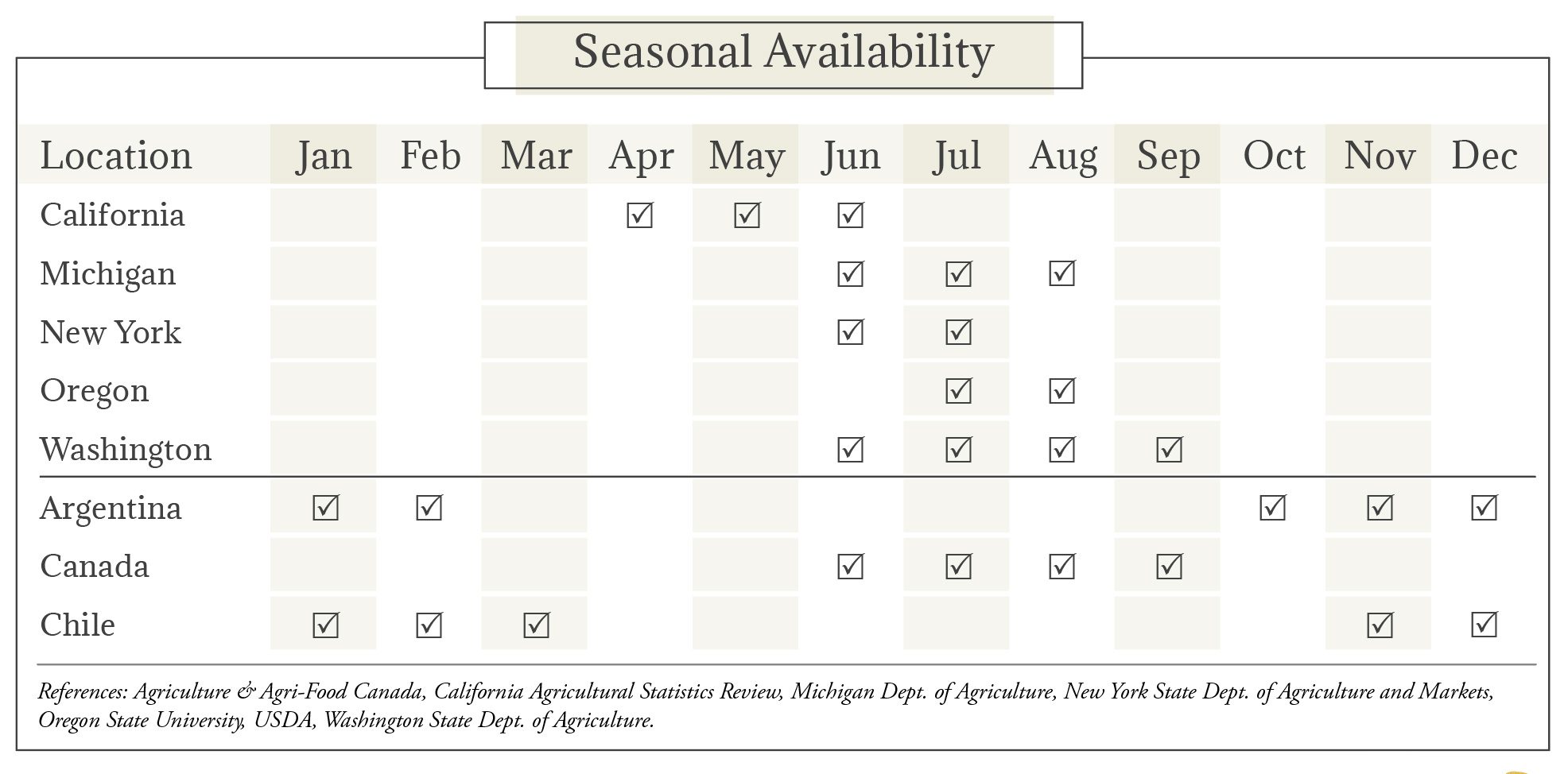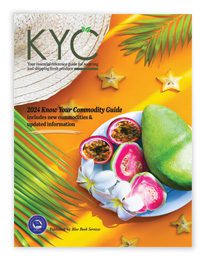Cherry Market Summary


Image: Malica/Shutterstock.com
Cherry Market Overview
Cherries (Prunus spp.) are members of the Rosaceae (or rose) family along with almonds, apricots, peaches, and plums. The two most common types of cherries are sweet cherries (Prunus avium L.) and sour (Prunus cerasus L.), often called tart cherries. Originally brought to the United States by English colonists in the early 1600s, Spanish missionaries brought cherries west to California. Washington, Oregon, and California are the country’s top growing regions, accounting for 90% of U.S. production. Sour cherries are grown primarily in Michigan, which accounts for nearly three-quarters of annual production.Types & Varieties of Cherries
Cherries can generally be classified as sweet or sour/tart. Less common varieties include Duke Cherries, a hybrid of sweet and sour, and Blushed Yellow Cherries, considered a niche category that can be rather difficult to grow and generally more expensive. About 75% of sweet cherries are grown for the fresh market with the rest sent for processing. Conversely, 99% of sour cherries are processed. The most common sour cherry variety is Montmorency. Popular sweet cherry varieties include Benton, Bing, Brooks, Chelan, Coral, Lambert, Lapin, Rainier, Regina, Royal Ann, Skeena, Sweetheart, Tieton, and Tulare. Low-chill California varieties begin the harvest season in mid-April and generally continue until June when the Washington harvests commence. Oregon follows and U.S. Pacific Northwest harvests end in August, while Canada extends into September. Fresh market standards for cherries are strict as the fruit is fragile and easily damaged. Fruit not meeting standards is sent for processing, where cherries are frozen, canned, juiced, brined, dried, or made into wine. Sweet cherries are often processed into Maraschino cherries and sour cherries are more often frozen.
Cultivation of Cherries
Ideal soil for cherry trees is deep, silt loam with low alkalinity and salinity. Cherries can, however, thrive on many types of soil provided it is well-drained and doesn’t remain heavy with moisture for long periods. Growers commonly plant sod between trees and plant in solid blocks on a raised ridge to encourage drainage and facilitate self-pollinators. Good air flow around the trees is important to discourage frost pockets. Sour cherries are self-fertile, while sweet cherries are self-incompatible and need another cultivar for pollination. Sweet cherry orchards need one alternate cultivar for every 8 or 9 trees. Planting at least 2 or 3 cultivars in an orchard is best. For some sweet cultivars, members of the same group will not pollinate each other, so growers must select compatible varieties within a grouping. For both types of cherry, 1 or 2 two honeybee hives per acre is optimal. Sweet cherries bloom before sour cherries, but both flower in early spring and are susceptible to frost damage. Cherry trees require a dormancy season with extended temperatures between 35 and 55°F to bloom during spring. Cherries grow for about 60 days after flowering and mature just over 3 months after pollination. Spurs at least 2 years old produce flowers and fruit. Early picking is not an option as cherries can only ripen on the tree, not after harvest. As trees mature, they are typically trained to either encourage growth along a few selected shoots (open-center training) or structured along a trellis (espalier training). Orchards are pruned each year to limit tree size and control growth; allow sunlight to penetrate the canopy; promote air circulation; strengthen trees; balance fruiting, flower growth, and vegetative growth; and prevent disease and insect spread. Pruning is generally done by hand. Sweet cherries are usually picked by color and size as the fruit gets larger and firmer as it ripens. Signs of maturity in both sweet and sour cherries include overall color from light to deep red and 14 to 16% soluble solids content. Heavy rains before harvest can cause significant losses due to cracking. Cracking is more common in sweet cherries than tart. Sweet cherry picking is labor-intensive, usually requiring upwards of 25 or more workers per acre to complete picking in one day. Sour cherries destined for processing can be mechanically harvested as they part more easily from trees as they ripen. Cherries are fragile and easily damaged; it is best to pick and cool the fruit as soon as possible after harvest, ideally within two hours. Humidity control is also important to prevent rapid moisture loss (100% humidity is ideal).Pests & Diseases Affecting Cherries
Pests of concern include the American plum borer, aphids, various fruit flies, leafhoppers, maggots, slug larvae, spotted wing drosophila, European red mites, lesser peachtree borer, and plum curculio. The Western cherry fruit fly and cherry leafhopper are two of the more serious pests. The western cherry fruit fly lays eggs that turn into maggots inside the fruit, potentially infesting every cherry on the tree. The cherry leafhopper is of particular concern because it can spread cherry buckskin disease. Symptoms vary depending on rootstock, but can include pale, curling foliage, pits and grooves in the tree’s wood, and sparse foliage. Fruit may also be lighter colored and with a characteristic leathery texture (i.e., buckskin). Cherries are also susceptible to blue mold, bacterial canker, black knot, grey mold, powdery mildew, and various types of rot. A more recent threat is the simply named ‘little cherry disease’ which produces small, sour fruit lacking proper color.Storage & Packaging of Cherries
Fresh market sweet cherries have a storage life of 2 to 3 weeks at 30 to 32°F and 90 to 95% relative humidity. Fresh market sour cherries have a storage life of 3 to 7 days at 32°F and 90 to 95% relative humidity. Cherries do produce a small amount of ethylene, but are not responsive to ethylene for ripening. References: Cornell University, PennState Extension, Purdue University, University of California Cooperative Extension, University of Kentucky, Washington State University, Western Growers Association.
Grades & Good Arrival of Cherries
Sweet cherries for the fresh market are graded as either U.S. No. 1 or U.S. Commercial. Fruit for U.S. No. 1 must have similar varietal characteristics and be mature, fairly well colored and formed, clean, free from decay, insect larvae or holes, sunscald, or other damage, as well as not soft, overripe, shriveled, or be an undeveloped double. Regarding size, unless otherwise specified, minimum diameter shall be not less than .75 inch each. Sour or tart cherries (canned or frozen) and sweet cherries for canning or freezing have separate grade and tolerance information. For U.S. Commercial grade cherries, fruit must meet the requirements for U.S. No. 1 except for minimum diameter and increased tolerances. For size, unless otherwise specified, diameter must not be less than 5/8 of an inch; maximum diameter in any lot depends on specific tolerance information.SWEET CHERRIES (U.S. No.1)
| U.S. Grade Standards | Days Since Shipment | % of Defects Allowed | Optimum Transit Temp. (F) |
| 12-6-2 | 5 4 3 2 1 | 15-8-3 14-8-3 13-7-2 13-6-2 12-6-2 | 30-32° |
SWEET CHERRIES (Wash No.1)
| U.S. Grade Standards | Days Since Shipment | % of Defects Allowed | Optimum Transit Temp. (F) |
| 24-6-2 | 5 4 3 2 1 | 30-8-3 29-8-3 27-7-2 26-6-2 24-6-2 | 32° |



